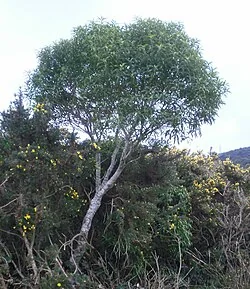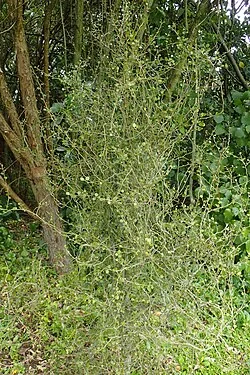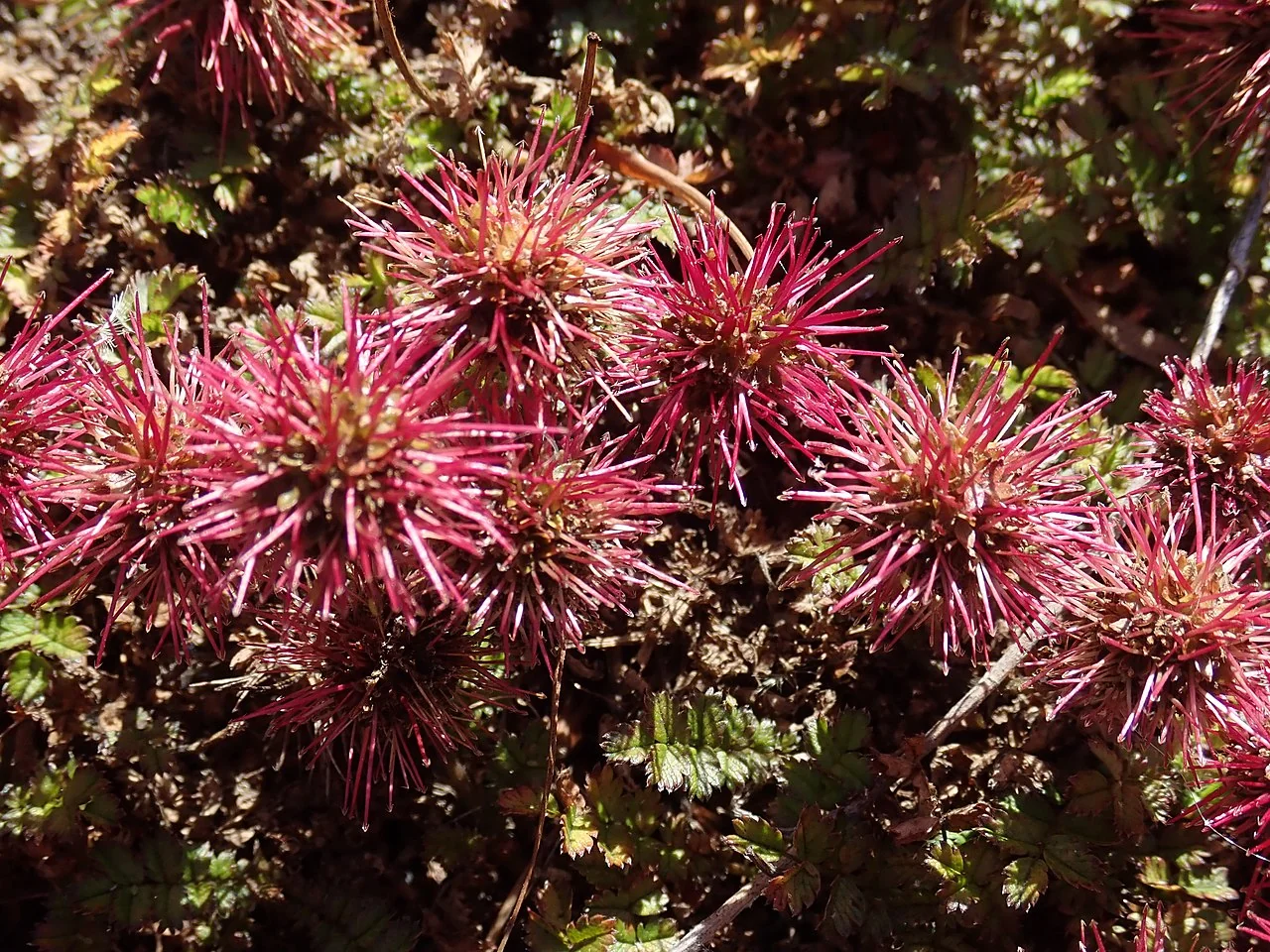
Whiteywood
Melicytus ramiflorus
Whiteywood ( Melicytus ramiflorus ), also known as Māhoe, is one of New Zealand's most common and widespread native trees, celebrated for its distinctive pale bark, heart-shaped leaves, and profusion of tiny, fragrant greenish-yellow flowers. This small to medium-sized evergreen tree is found throughout New Zealand, from coastal to montane forests. Its dense foliage and abundant berries make it a crucial food source for native birds and a valuable addition to native plant gardens, providing year-round interest and attracting wildlife. Whiteywood is a resilient and ecologically important tree that adds a touch of natural beauty to any landscape, showcasing the rich biodiversity of New Zealand's forests. For related species, see the native plants index .

Plant Description
Botanical Features
Whiteywood ( Melicytus ramiflorus ), also known as Māhoe, is a small to medium-sized evergreen tree endemic to New Zealand, growing up to 10-15 meters high with a trunk up to 60-80 cm in diameter. It typically has a knobbly, pale trunk and numerous brittle, twiggy branches. The bark is smooth and whitish or greyish-white, with a bright green underbark. Its leaves are yellow to dark green, 5-20 cm long and 3-5 cm wide, and are firmly fleshy, with coarsely serrated margins. Small, yellowish, or greenish-yellow flowers, 3-4 mm in diameter, appear in dense clusters directly from the branchlets or leaf axils in late spring and into summer. These flowers have a strong, pleasant fragrance. The berries are a striking violet, dark blue, or purple colour when ripe, typically 4-5 mm in diameter, and appear later in summer to autumn.
Quick Facts
Shrub Summary
| Scientific Name | Melicytus Ramiflorus |
|---|---|
| Common Name | Whiteywood, Māhoe |
| Family | Violaceae |
| Height | Up to 10 m |
| Spread | Up to 5 m |
| Light | Full sun to partial shade |
| Soil | Moist, well-drained, fertile soils |
| Water Needs | Moderate |
| Frost Tolerance | Moderate |
| Salt Tolerance | Moderate |
| Growth Rate | Medium to fast |
| Lifespan | Long |
Climate Best Suited to
Regional Suitability
Whiteywood ( Melicytus ramiflorus ) is widely distributed throughout New Zealand, from coastal to montane forests, indicating its broad adaptability to various climates. It thrives in mild, temperate climates with consistent rainfall and moderate temperatures. It is reasonably tolerant of wind and some salt spray, making it suitable for coastal gardens, but prefers sheltered locations away from extreme exposure. Its natural habitat includes forest margins, open areas, and stream banks. It can be successfully cultivated in most temperate regions, provided it has good drainage and protection from extreme heat or prolonged severe frosts when young.
| Whangārei | Ideal |
| Auckland | Ideal |
| Hamilton | Suitable |
| Rotorua | Suitable |
| Tauranga | Ideal |
| Gisborne | Ideal |
| New Plymouth | Ideal |
| Whanganui | Ideal |
| Palmerston North | Suitable |
| Napier | Ideal |
| Wellington | Ideal |
| Nelson | Ideal |
| Christchurch | Suitable |
| Dunedin | Suitable |
| Invercargill | Suitable |
| City | Climate Suitability |
|---|
Natural Habitat
Forest Distribution
Understand the natural habitat of Whiteywood ( Melicytus ramiflorus ), which is found throughout New Zealand, in lowland and montane forests. This section details its geographical distribution, preferred environmental conditions, and the types of ecosystems where it naturally occurs.
- Widespread across New Zealand, from sea level to moderate altitudes.
- Found in lowland and montane forests, often in damp gullies and understories.
- Prefers sheltered sites with good air circulation.
- Thrives in full sun to partial shade.
Its broad habitat range highlights its adaptability and resilience, making it a fascinating subject for ecological study.
Plant Conservation
Melicytus ramiflorus , also known as Māhoe or whitey wood, is currently classified as "Not Threatened" in terms of its conservation status. This applies to the subspecies Melicytus ramiflorus subsp. ramiflorus in New Zealand. It is an abundant small tree found in coastal, lowland, and lower montane forests throughout New Zealand. Regional conservation statuses in areas like Auckland and Otago also list it as "Regionally Not Threatened."
Growing Requirements
Soil Requirements
Whiteywood thrives in well-drained, fertile soils. It is adaptable to a range of soil types, including sandy, loamy, and even some clay soils, but good drainage is crucial to prevent root rot. Incorporating organic matter can improve soil structure and moisture retention. A neutral to slightly acidic pH is generally preferred.
- Prefers well-drained, fertile soils.
- Adaptable to sandy or loamy soil types.
- Good drainage is essential.
- Neutral to slightly acidic pH preferred.
Light Requirements
Whiteywood performs well in full sun to partial shade. In full sun, it tends to be denser and more compact, producing more flowers. In partial shade, it may grow a bit more open but will still thrive. Ensure it receives adequate light for healthy growth and flowering.
- Full sun to partial shade.
- Denser growth and more flowers in full sun.
- Adaptable to various light conditions.
Water Requirements
Whiteywood requires moderate watering, especially during dry periods and its establishment phase. Once established, it is reasonably drought-tolerant but will benefit from occasional deep watering during prolonged dry spells. Ensure the soil is consistently moist but not waterlogged.
- Moderate watering needs.
- Drought-tolerant once established.
- Avoid waterlogging.
Planting Guide
Best Time to Plant
The best time to plant Whiteywood is during autumn or spring, when temperatures are mild and rainfall is more consistent. This allows the tree to establish its root system before the extremes of summer heat or winter cold.
Choosing a Location
Select a site with full sun to partial shade and well-drained, fertile soil. Whiteywood is highly adaptable and can be planted in coastal areas, exposed sites, or more sheltered garden beds. Ensure it has adequate space for its mature size if not being regularly pruned.
Planting Steps
- Dig a hole twice the width of the root ball and the same depth.
- Gently remove the tree from its container, being careful not to disturb the roots.
- Place the tree in the hole, ensuring the top of the root ball is level with the surrounding soil.
- Backfill with amended soil, firming gently around the base of the tree.
- Water thoroughly immediately after planting to settle the soil.
- Apply a layer of organic mulch to help retain moisture and suppress weeds, keeping it away from the trunk.
Initial Care
Water regularly during the first 6-12 months to help establish a strong root system. Once established, Whiteywood is reasonably low maintenance and requires less frequent watering. Protect young trees from strong winds and severe frosts if necessary.
Ecological Role
Forest Ecosystem Importance
The ecological importance of Whiteywood ( Melicytus ramiflorus ) within its native New Zealand ecosystems is significant. Its berries provide a crucial food source for native birds, particularly the kererū, which in turn aid in seed dispersal, playing a key role in forest regeneration. Its dense foliage also provides shelter for small birds and invertebrates.
- Berries are a crucial food source for native birds (e.g., tūī, bellbirds).
- Aids in seed dispersal and forest regeneration.
- Provides shelter for small birds and invertebrates.
- Contributes to biodiversity in diverse forest ecosystems.
As an endemic species, it is an integral part of the unique biodiversity that has evolved in New Zealand, supporting the delicate balance of its natural habitats.
Uses and Significance
Garden Uses
- Excellent specimen tree for larger gardens.
- Suitable for native plant gardens, shelterbelts, and screens.
- Provides year-round interest with evergreen leaves and flowers.
- Attracts native birds to its berries.
Cultural Significance
Melicytus ramiflorus , commonly known as māhoe or whiteywood, holds significant cultural importance, particularly within Māori traditions in New Zealand. Its uses span medicinal, practical, and spiritual aspects.
Key Cultural Significances Include:
- Fire-making: Māhoe wood was a vital component in traditional Māori fire-making by friction, often serving as the base wood. Its slow-burning properties also made it useful for carrying fire over distances.
- Māori Mythology: The tree is linked to the Māori legend of Māui and Mahuika, the fire goddess, as one of the trees said to have received the secret of fire.
- Medicinal Applications: Māori used māhoe for various medicinal purposes. Boiled leaves were applied to treat scabies and sores, while the bark served as a bandage for burns or was used in baths to address tuberculosis. Bushmen also chewed māhoe leaves to stimulate saliva and alleviate thirst.
- TÄā Moko (Māori Tattooing): The berries of Melicytus ramiflorus were a key ingredient in the ink used for TÄā Moko, Māori tattooing, often mixed with other natural substances like the Ophiocordyceps robertsii fungus and kauri gum. The wood was also fashioned into soft mallets used in the tattooing process.
- Other Uses: The bark was utilized to produce a yellow dye. The wood was also employed in the creation of tools, weapons, and utensils. Historically, early European settlers also used māhoe wood to produce charcoal for gunpowder. In some northern regions, it was used ceremonially for firing bracken before harvesting fernroot.
Beyond its direct cultural uses, māhoe also plays an important ecological role, providing habitat and food for native birds and geckos, and is frequently used in ecological restoration projects. Like other native species such as the tree nettle , māhoe demonstrates the interconnected nature of New Zealand's forest ecosystems.
Landscaping Applications
Garden Design Uses
Whiteywood ( Melicytus ramiflorus ) is a highly attractive and versatile tree for various landscaping applications, particularly in native and shaded gardens. Its graceful form and abundant berries make it a valuable asset.
- Ideal as a specimen tree for larger gardens and parks.
- Excellent for native forest restoration and revegetation projects.
- Provides year-round interest with evergreen leaves and berries.
- Suitable for mass plantings or as an accent plant.
Its ability to thrive in sheltered, shaded conditions and its aesthetic appeal make it a popular choice for creating lush and beautiful native landscapes.
Seasonal Care Calendar
Spring
New growth emerges, and tiny, fragrant greenish-yellow flowers appear. This is an ideal time for planting new Whiteywood specimens or propagating from cuttings. Ensure consistent moisture for young trees and protect them from strong winds if necessary. A light feed with a balanced slow-release fertilizer can encourage vigorous growth.
- Ideal time for planting and propagation.
- Ensure consistent moisture for new trees.
- Light fertilization if needed.
Summer
Whiteywood is actively growing and flowering profusely during summer, followed by the development of berries. Consistent watering is crucial, especially during dry spells, to prevent stress. Monitor for pests and diseases, though it is generally quite resilient.
- Active growth and abundant flowering.
- Consistent watering is essential.
- Monitor for pests and diseases.
Autumn
Berries ripen and become prominent in autumn, providing a valuable food source for native birds. This is another good time for planting, allowing roots to establish before winter. Minimal care is required for established trees, but ensure they remain adequately hydrated.
- Berries ripen, attracting birds.
- Good time for planting.
- Minimal care for established trees.
- Ensure adequate hydration.
Winter
Whiteywood is evergreen and provides year-round interest. It is moderately frost-tolerant and requires minimal care during this period. Ensure good drainage to prevent root issues in wet conditions.
- Evergreen, provides year-round interest.
- Protect young trees from severe frost.
- Ensure good drainage.
When to Prune and How Much
Regular Pruning
Whiteywood generally requires minimal pruning to maintain its natural form. The primary reason for pruning is to remove dead or damaged branches, or to shape the tree as desired. Its natural growth habit is often quite attractive, so extensive pruning is rarely needed.
- Remove dead or damaged branches as needed.
- Light shaping to maintain desired form.
- Best done in late winter or early spring before new growth.
- Use clean, sharp tools.
Avoid heavy pruning, as this can stress the tree. Allow it to develop its natural, graceful canopy.
How to Grow Whiteywood
Whiteywood, also known as Māhoe, is one of New Zealand's most common and widespread native trees, celebrated for its distinctive pale bark, heart-shaped leaves, and profusion of tiny, fragrant greenish-yellow flowers. This small to medium-sized evergreen tree is found throughout New Zealand, from coastal to montane forests. Its dense foliage and abundant berries make it a crucial food source for native birds and a valuable addition to native plant gardens, providing year-round interest and attracting wildlife. Whiteywood is a resilient and ecologically important tree that adds a touch of natural beauty to any landscape, showcasing the rich biodiversity of New Zealand's forests. Understanding its propagation methods is key to successfully growing this delightful species.
From Seed
Propagating Whiteywood from fresh seed is a viable method, though germination can be slow and may require stratification. Collect ripe berries in late autumn or early winter. Clean the seeds thoroughly to remove any fleshy pulp. Sow the seeds in a tray filled with a well-draining seed-raising mix, lightly covering them. The seeds typically require a period of cold stratification (e.g., refrigerate for 2-3 months) to break dormancy. Maintain consistent moisture in the seed tray and keep it in a warm, sheltered location. Germination can take several weeks to months after stratification. Once seedlings have developed a few true leaves, they can be potted into individual containers and grown in a sheltered environment before planting out.
From Cuttings
Semi-hardwood cuttings are a reliable method for propagating Whiteywood, ensuring that new plants retain the exact characteristics of the parent. Take 10-15 cm cuttings from healthy, semi-hardwood stems in late summer or early autumn. Remove the lower leaves and dip the cut end in a rooting hormone. Insert the cuttings into a well-draining propagation mix (e.g., sand and perlite). Keep the cuttings in a warm, humid environment, out of direct sunlight, perhaps under a plastic dome or in a propagator. Rooting typically occurs within 8-12 weeks. Once rooted, the new plants can be potted on and grown in a sheltered environment until they are ready for planting.
Pests and Diseases
Whiteywood is generally a robust tree, but it can be susceptible to certain pests and diseases, especially if not grown in optimal conditions.
Common Pests
- Aphids: Can infest new growth. Treat with insecticidal soap or remove manually.
- Scale Insects: May be present on stems and leaves. Treat with horticultural oil or appropriate insecticides.
Common Diseases
- Sooty Mould: Often associated with scale insect infestations, it can cover leaves and reduce photosynthesis. Address the underlying pest issue.
- Root Rot: Caused by overwatering or poor drainage. Ensure well-drained soil.
Good garden hygiene, proper watering, and adequate air circulation are key to preventing most pest and disease issues. Regular inspection will help catch problems early.
Bonus Tip
Expert Growing Advice
The name "Whiteywood" comes from the tree's distinctive pale bark, which can appear almost white in certain light. This makes it easy to identify, even from a distance. The scientific name, ramiflorus , means "branch-flowering", referring to the way the flowers and berries grow directly from the branches.







